实例介绍
【实例截图】
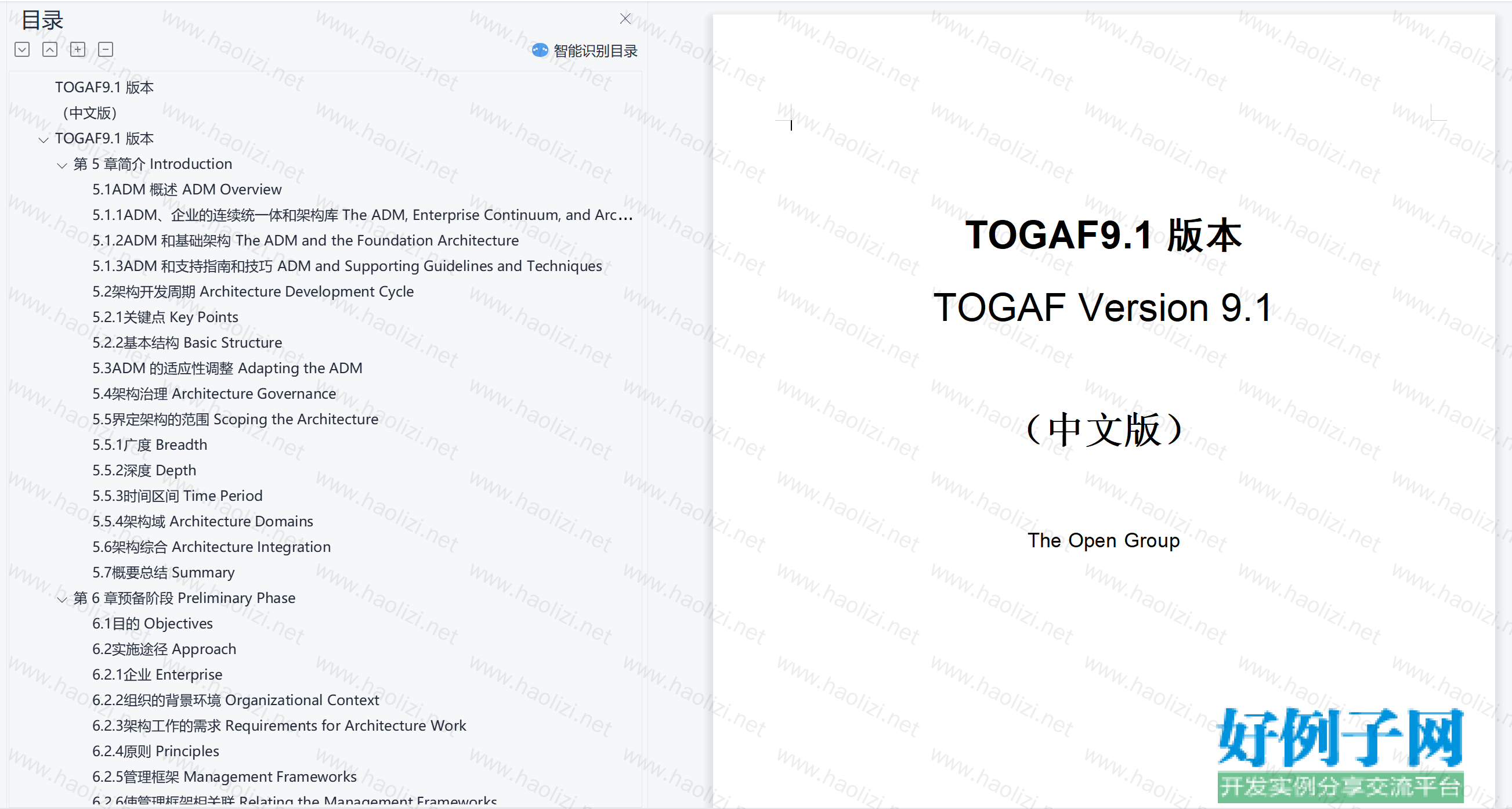
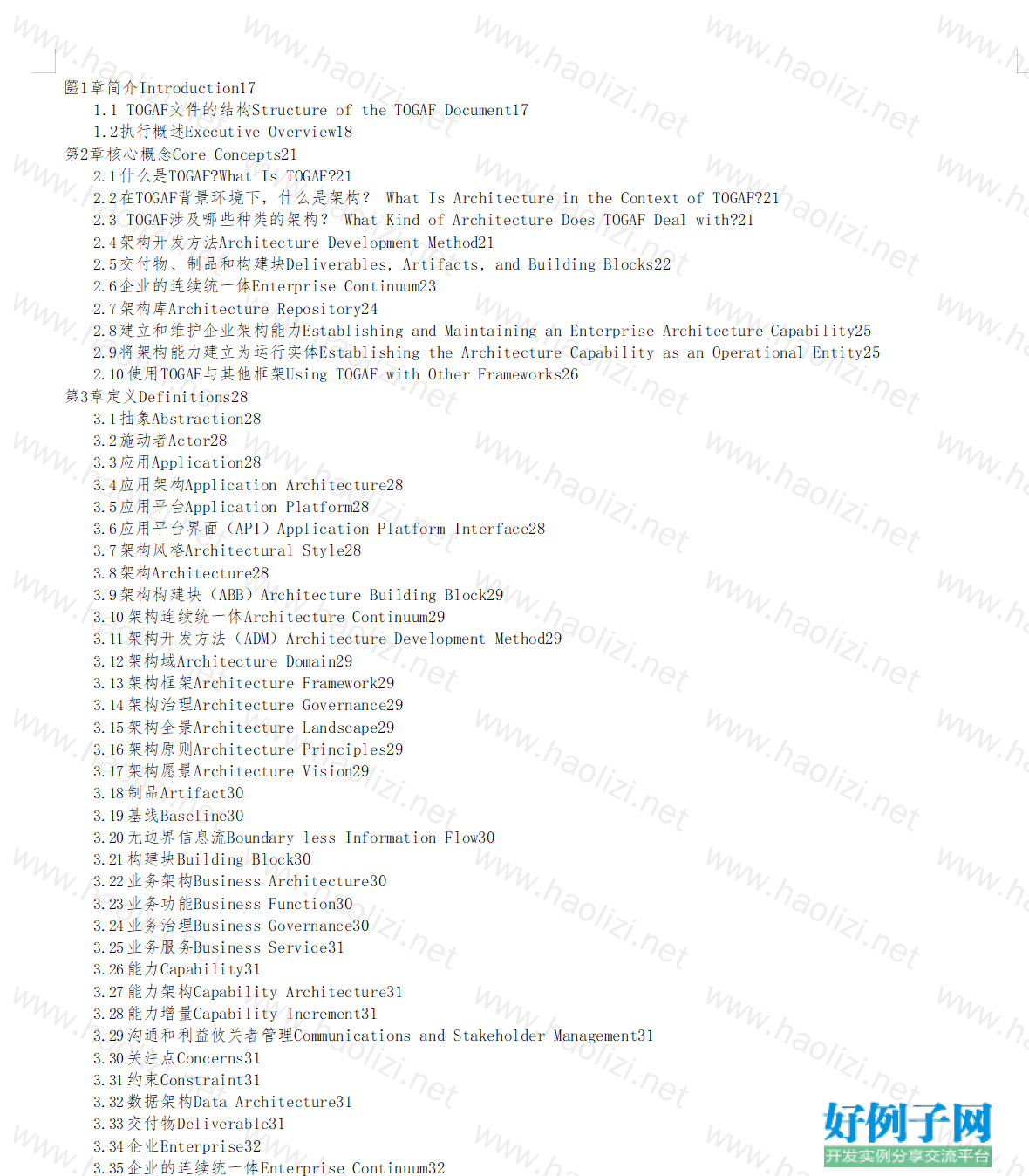
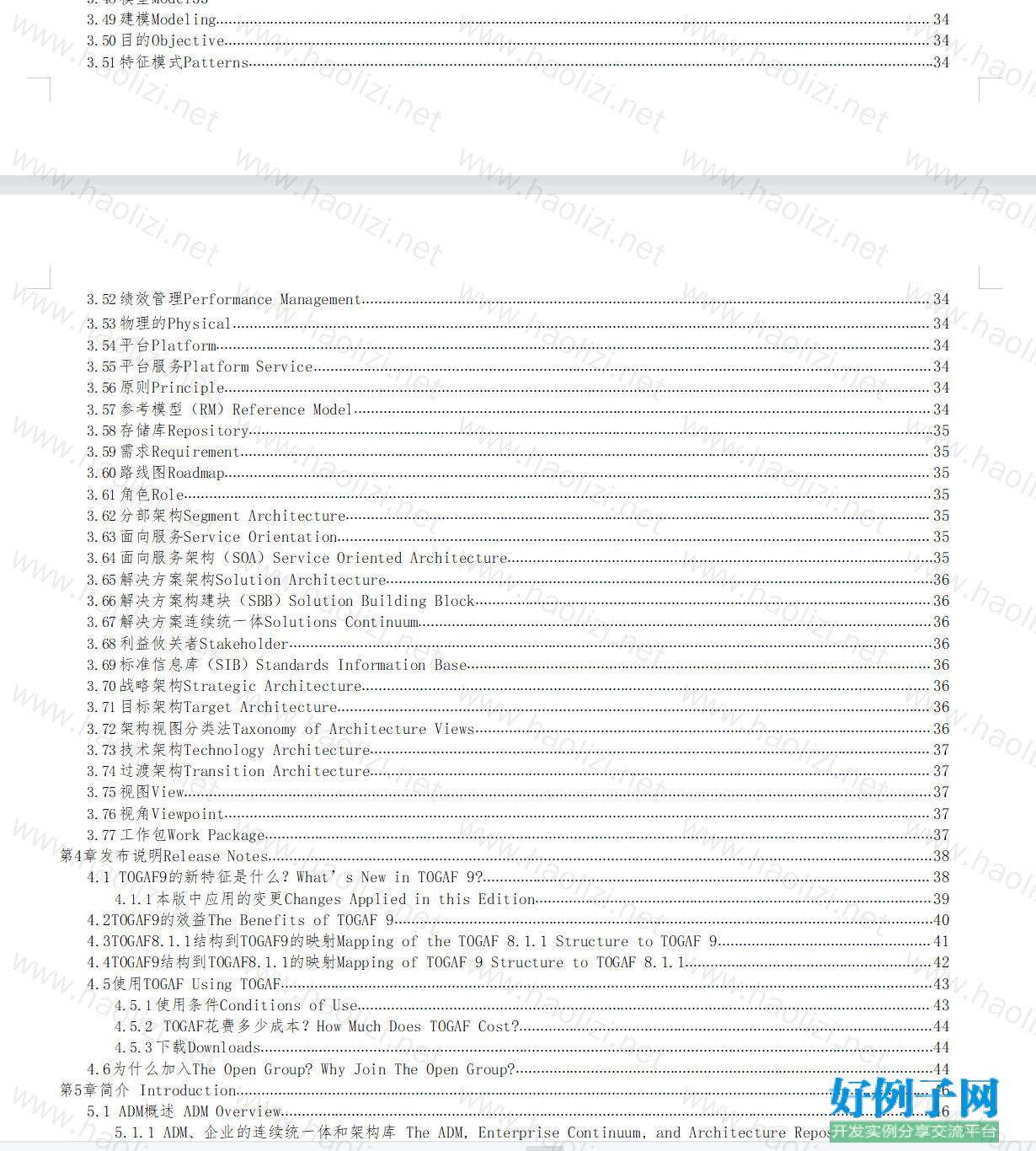
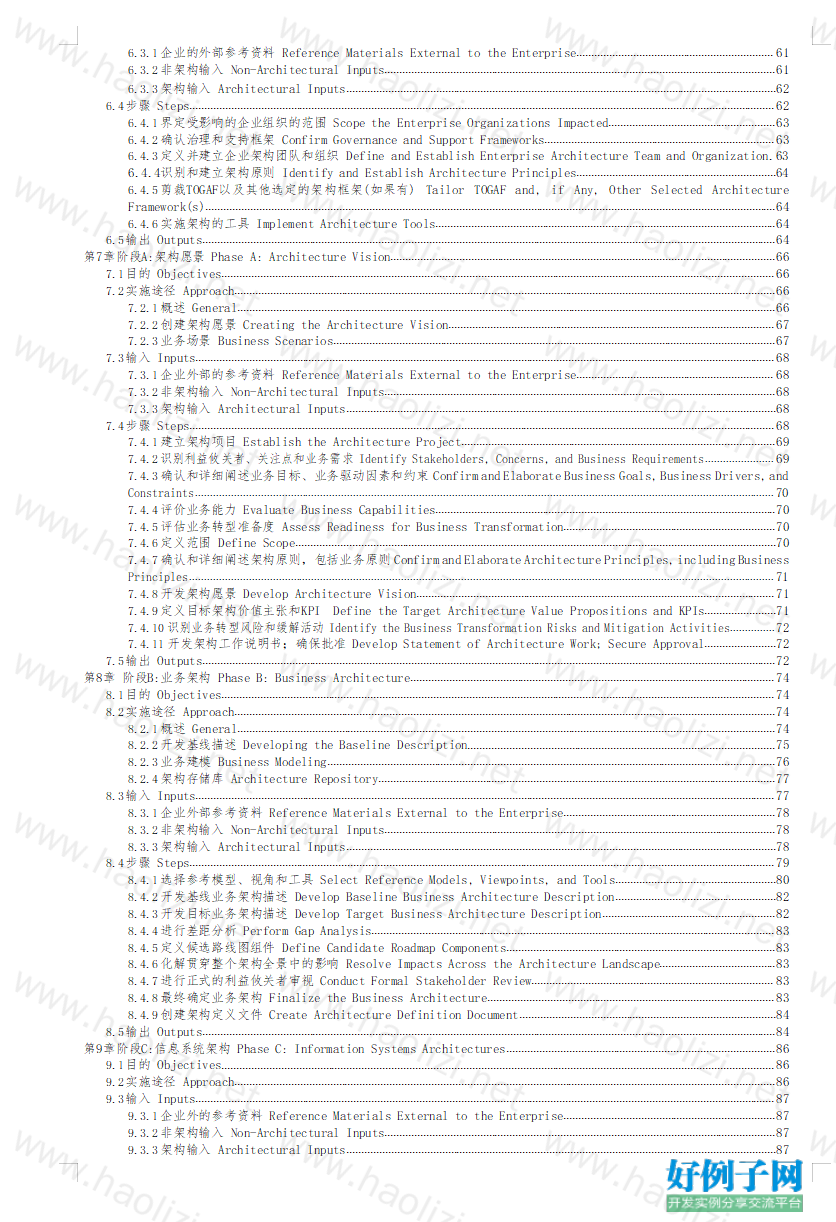
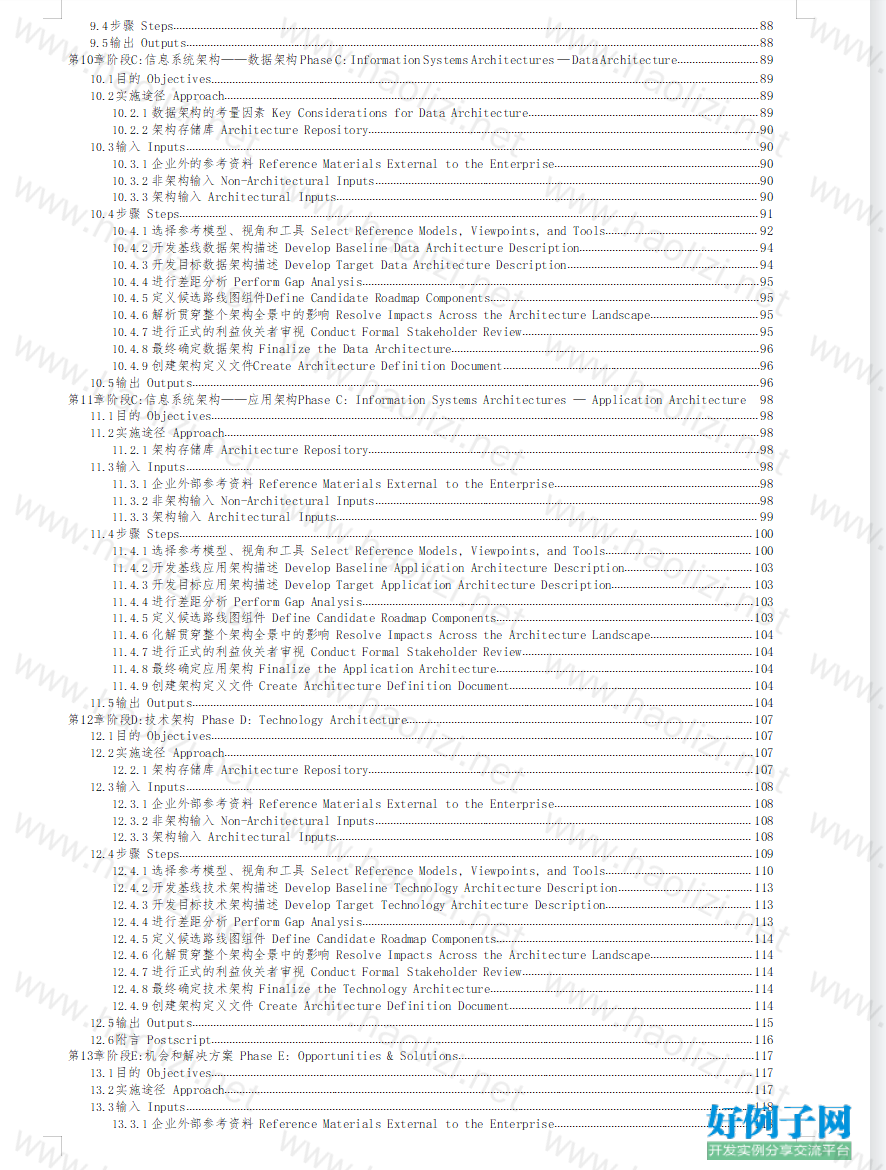
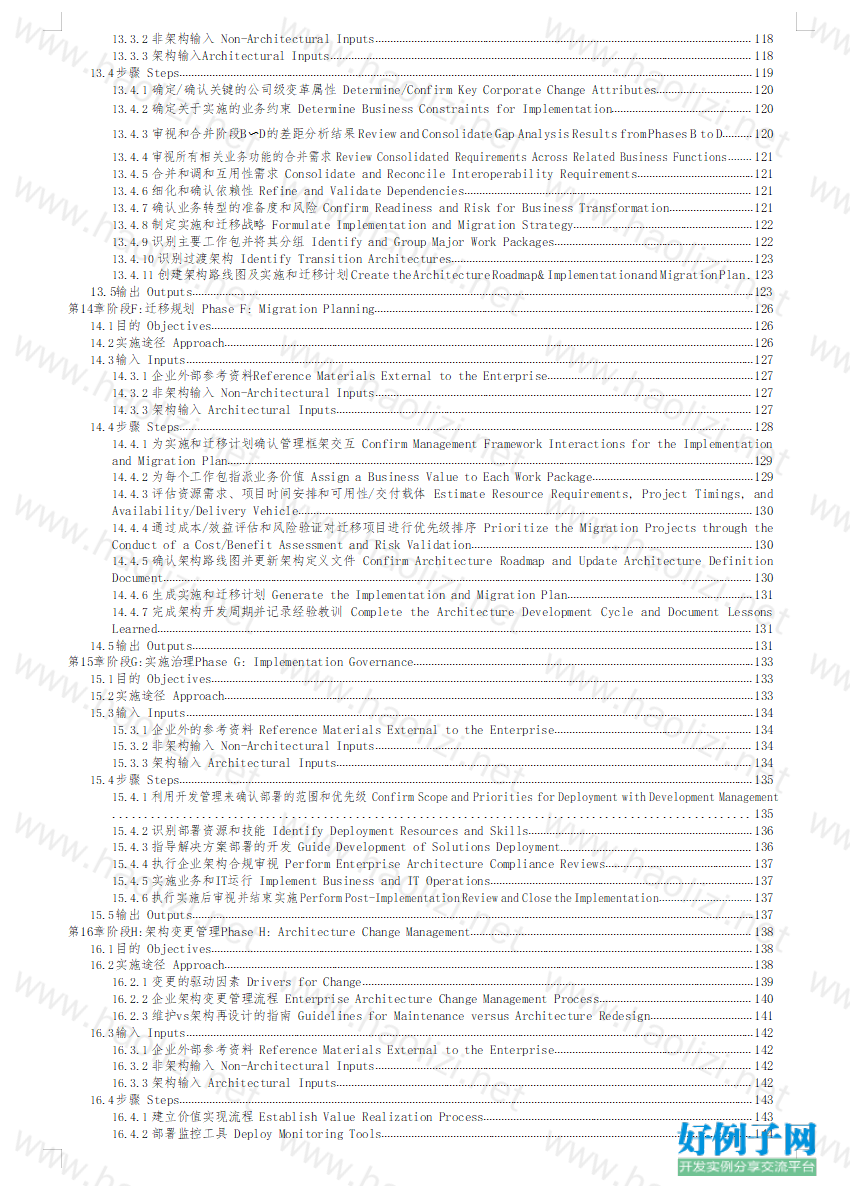
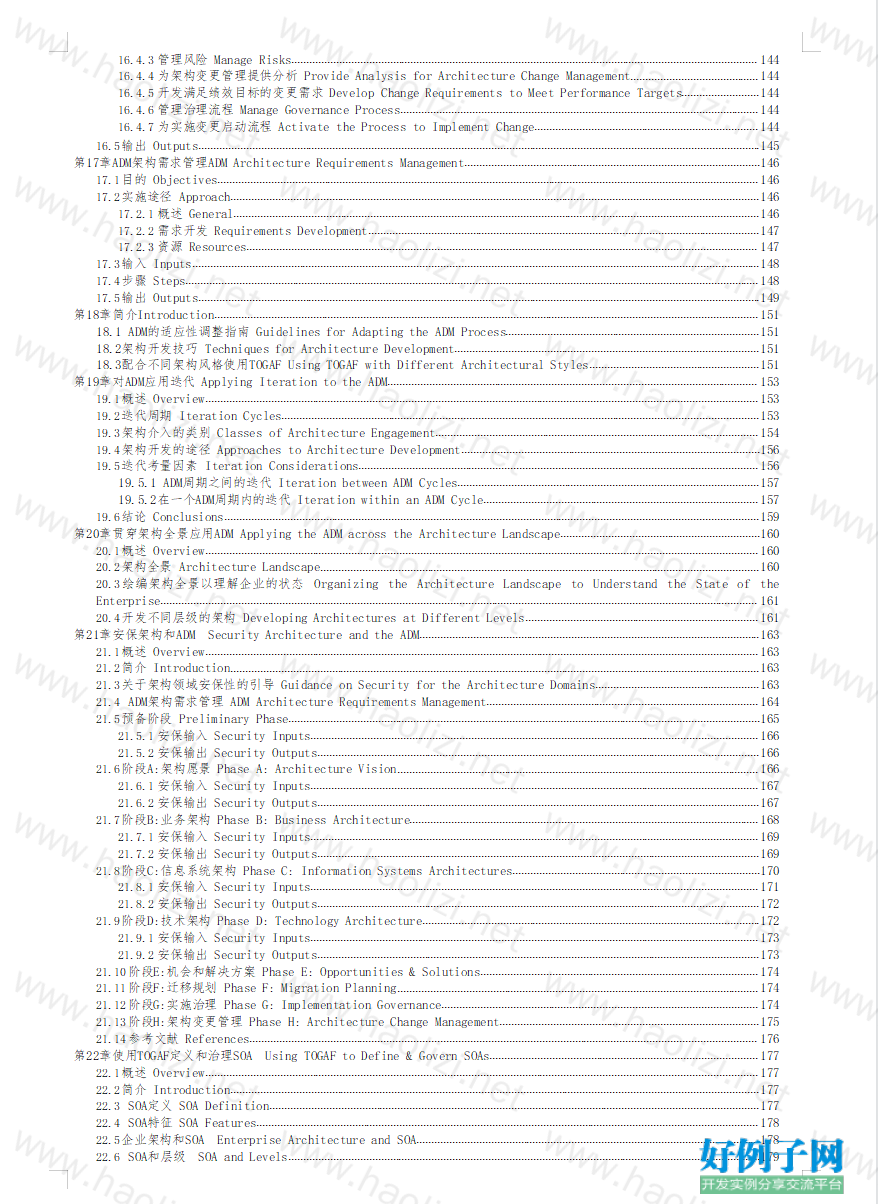
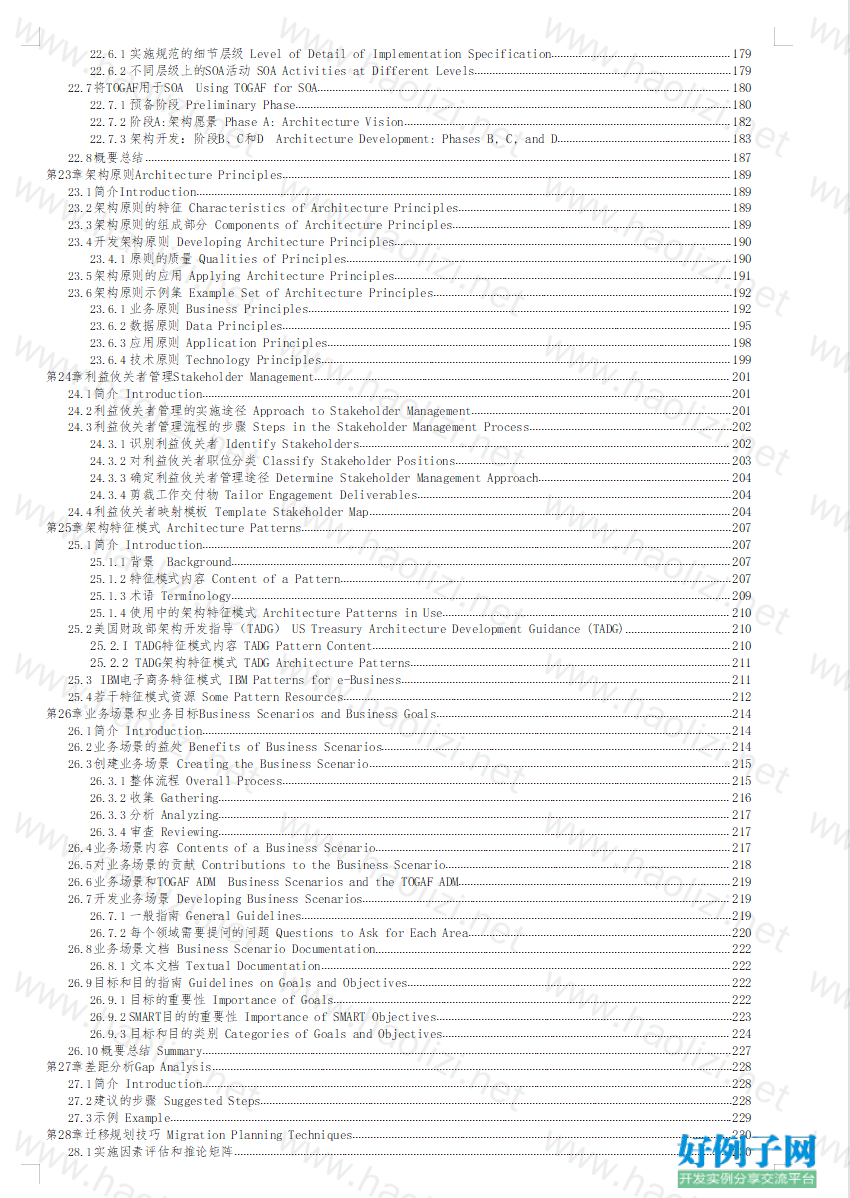
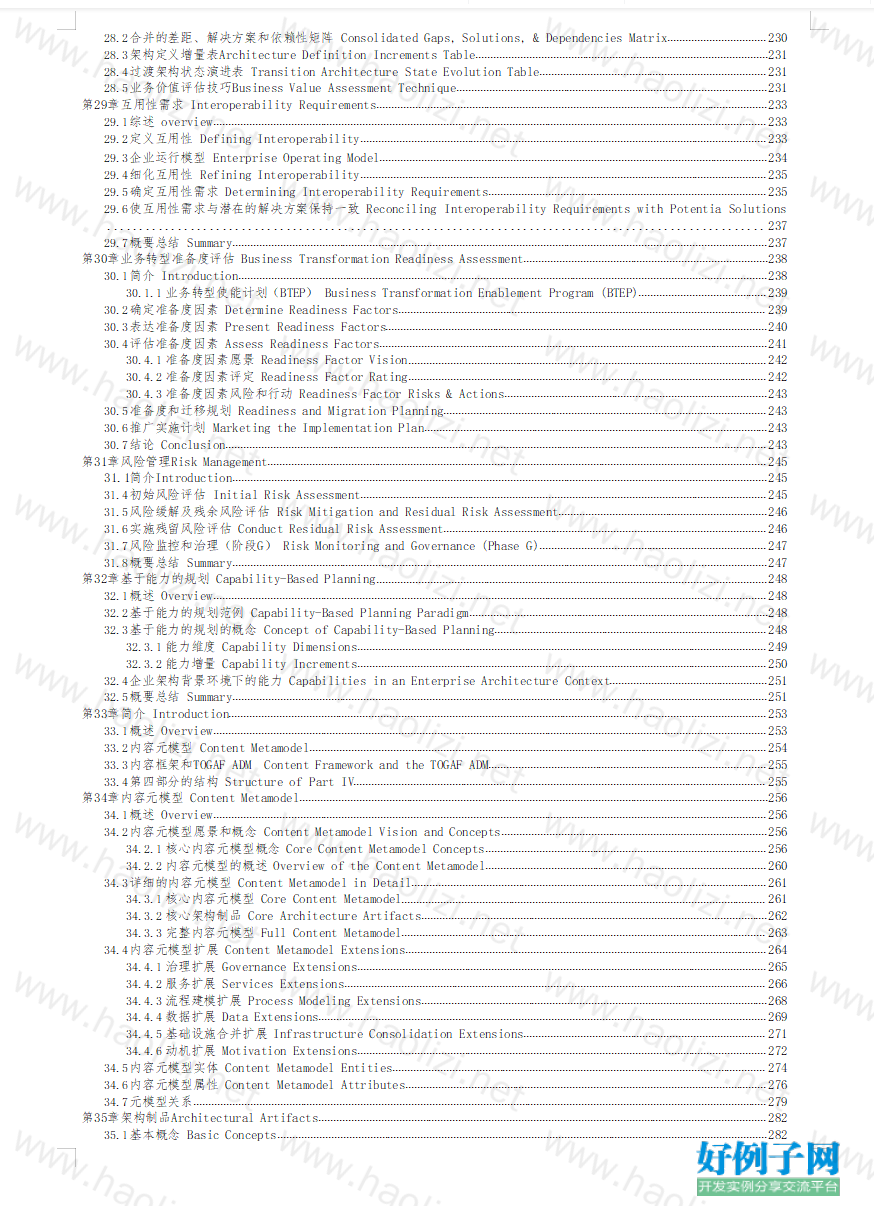
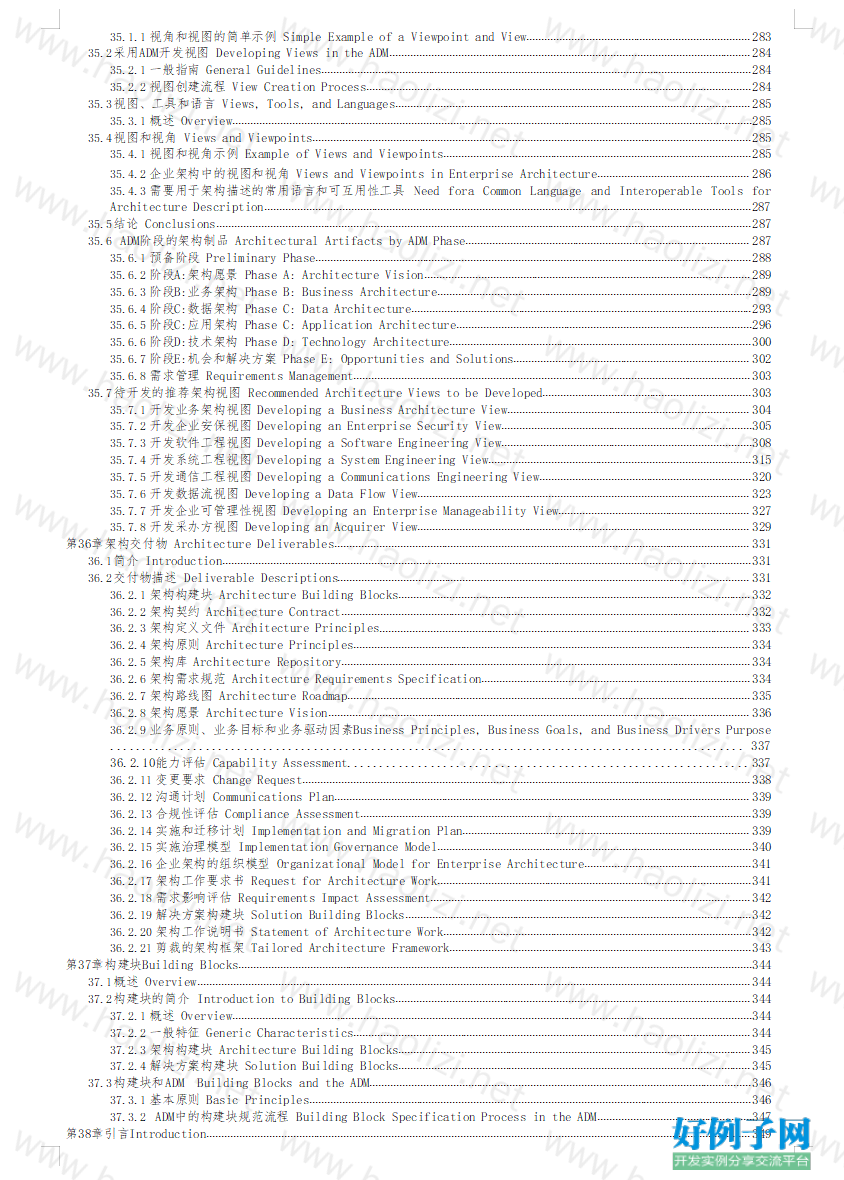
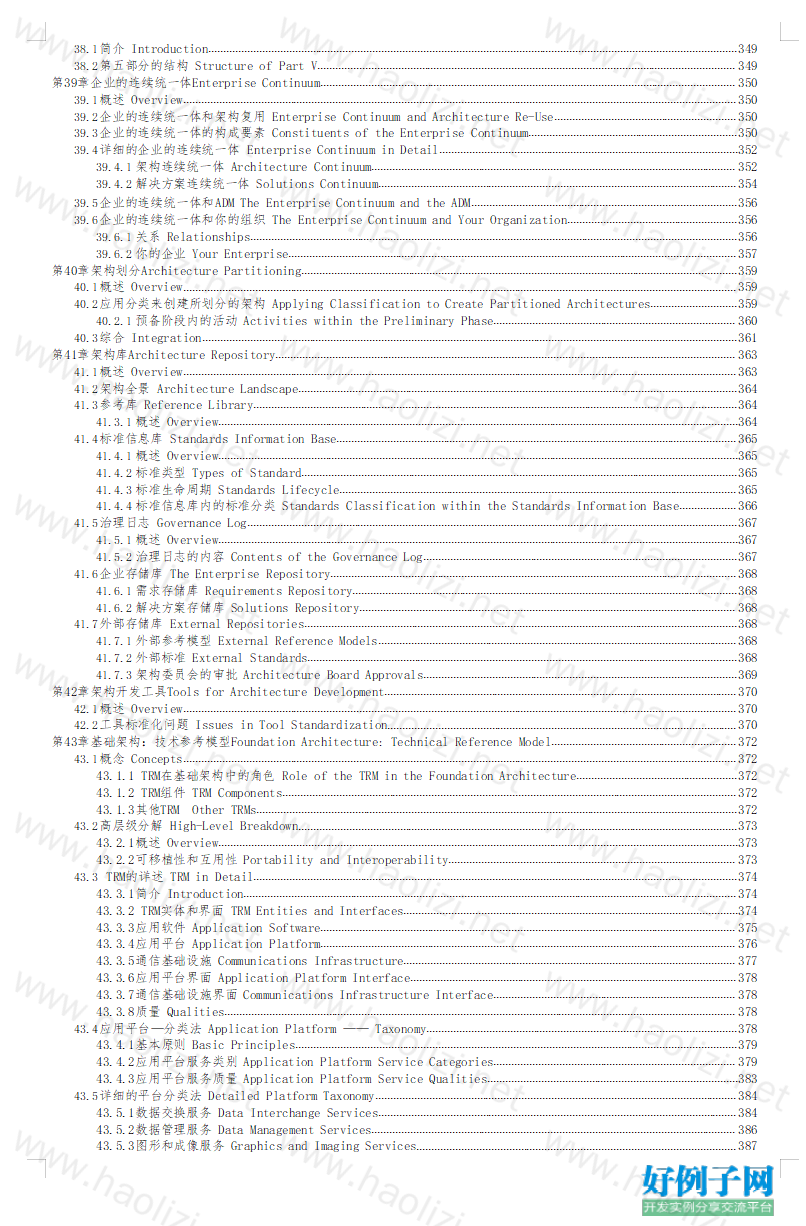
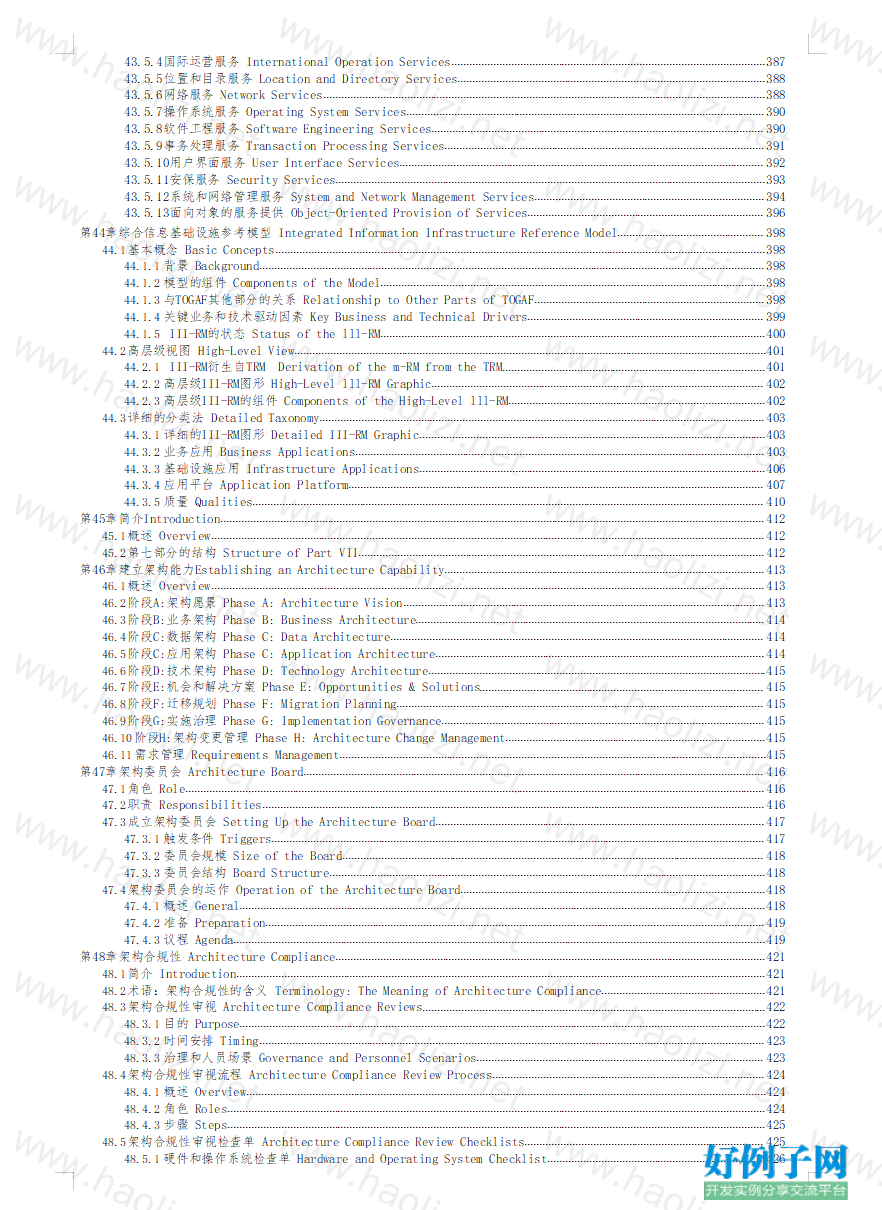
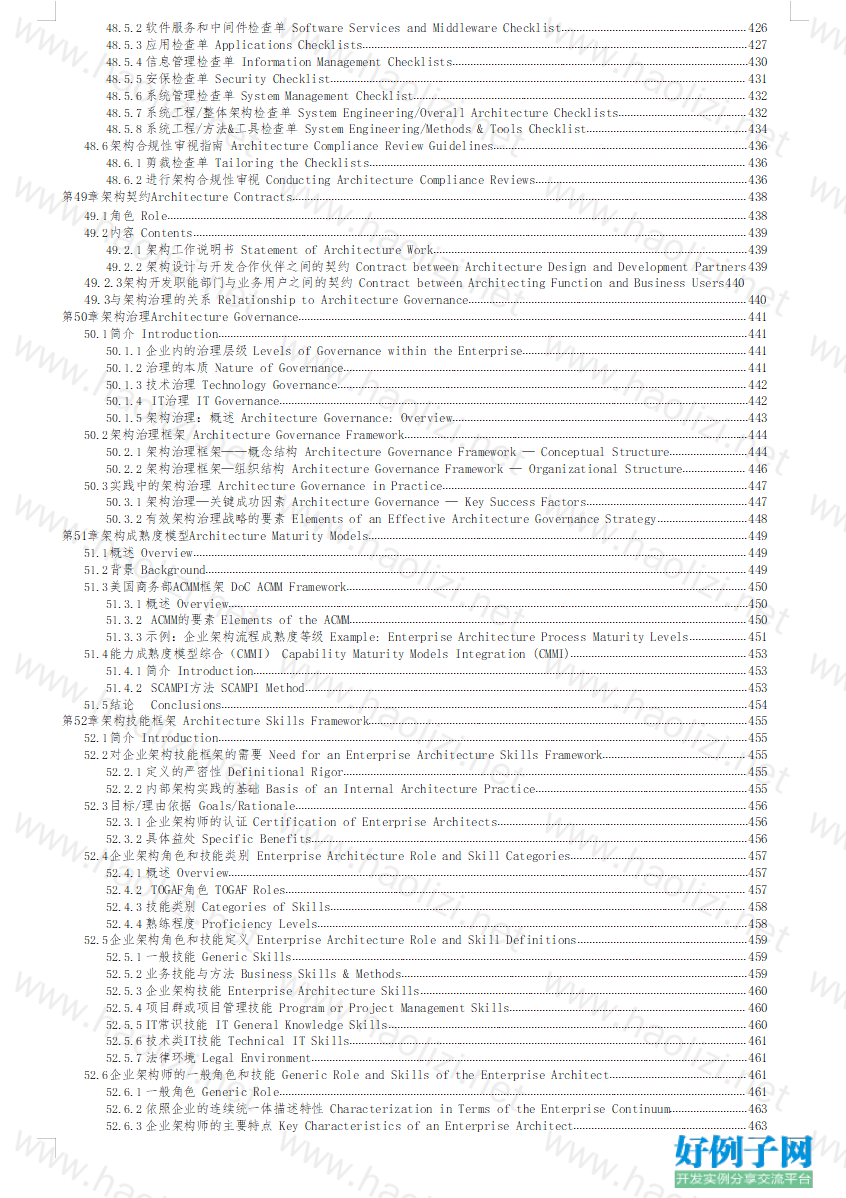
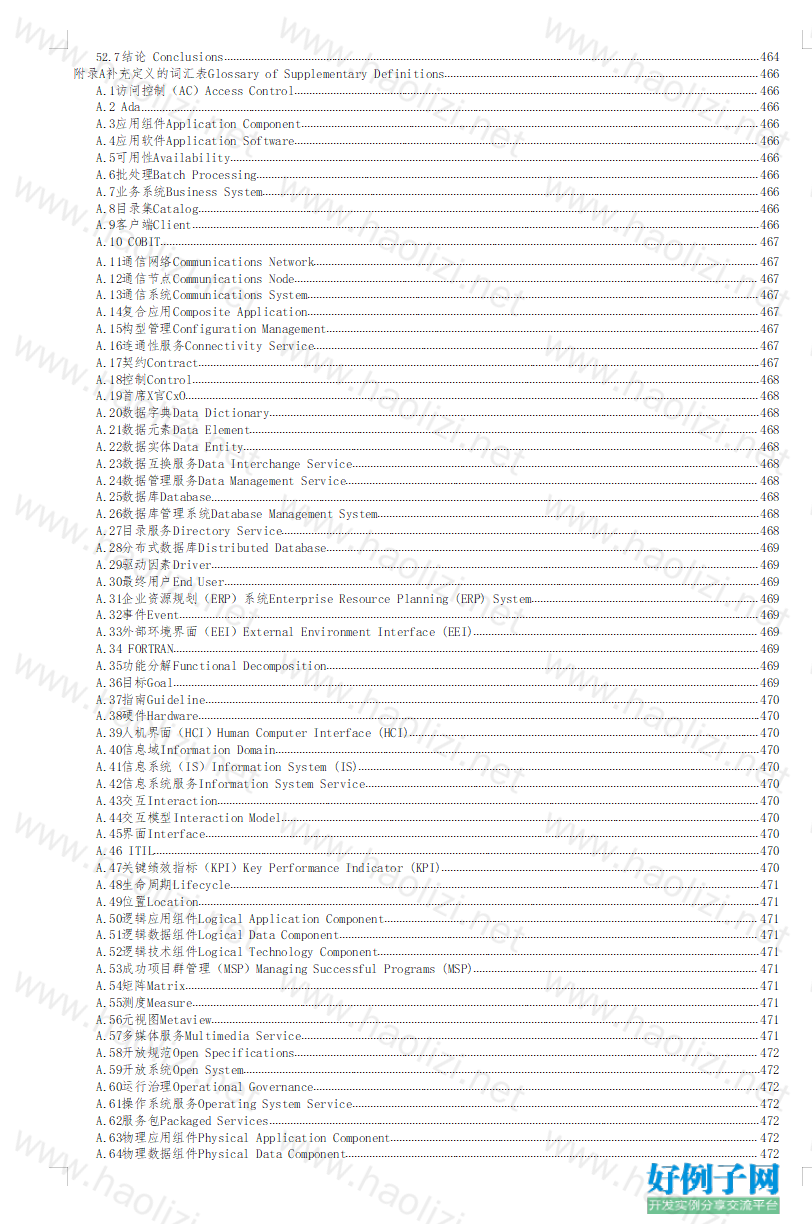
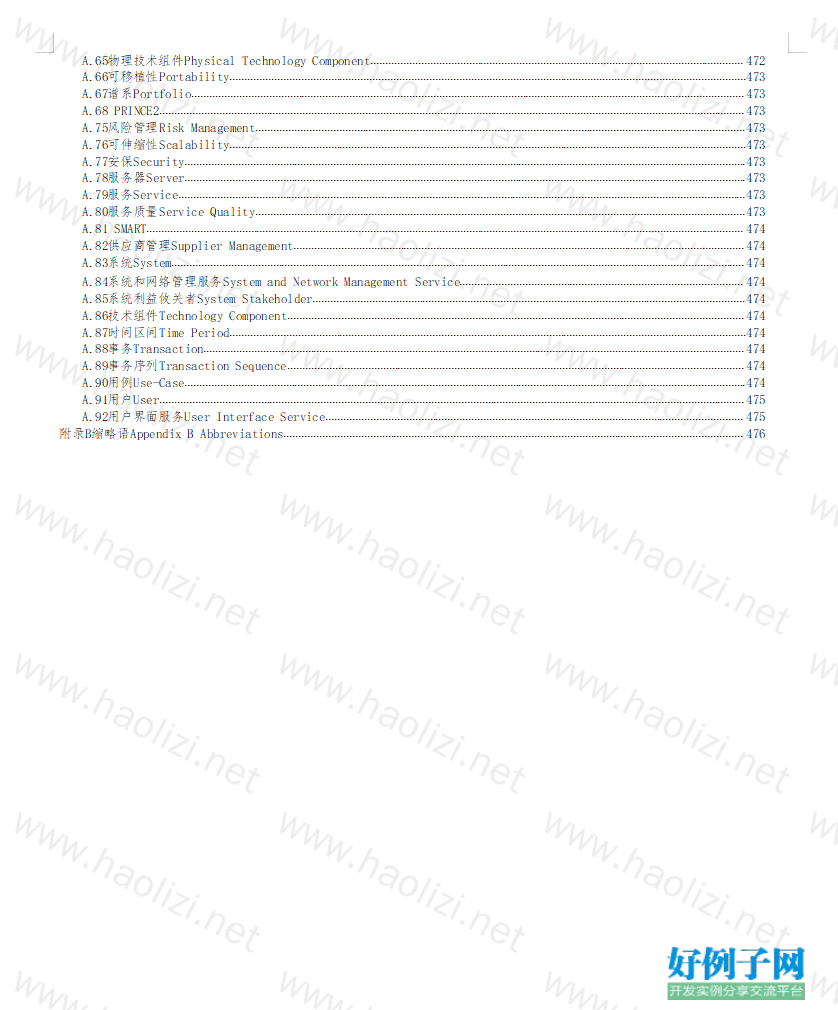
【核心代码】
1.1 TOGAF文件的结构Structure of the TOGAF Document 17
2.1 什么是TOGAF? What Is TOGAF? 21
2.2 在TOGAF背景环境下,什么是架构? What Is Architecture in the Context of TOGAF? 21
2.3 TOGAF涉及哪些种类的架构? What Kind of Architecture Does TOGAF Deal with? 21
2.4 架构开发方法Architecture Development Method 21
2.5 交付物、制品和构建块Deliverables, Artifacts, and Building Blocks 22
2.6 企业的连续统一体Enterprise Continuum 23
2.7 架构库Architecture Repository 24
2.8 建立和维护企业架构能力Establishing and Maintaining an Enterprise Architecture Capability 25
2.9 将架构能力建立为运行实体Establishing the Architecture Capability as an Operational Entity 25
2.10 使用TOGAF与其他框架Using TOGAF with Other Frameworks 26
3.1 抽象Abstraction 28
3.2 施动者Actor 28
3.3 应用Application 28
3.4 应用架构Application Architecture 28
3.5 应用平台Application Platform 28
3.6 应用平台界面(API)Application Platform Interface 28
3.7 架构风格Architectural Style 28
3.9 架构构建块(ABB)Architecture Building Block 29
3.10 架构连续统一体Architecture Continuum 29
3.11 架构开发方法(ADM)Architecture Development Method 29
3.12 架构域Architecture Domain 29
3.13 架构框架Architecture Framework 29
3.14 架构治理Architecture Governance 29
3.15 架构全景Architecture Landscape 29
3.16 架构原则Architecture Principles 29
3.17 架构愿景Architecture Vision 29
3.18 制品Artifact 30
3.19 基线Baseline 30
3.20 无边界信息流Boundary less Information Flow 30
3.21 构建块Building Block 30
3.22 业务架构Business Architecture 30
3.24 业务治理Business Governance 30
3.26 能力Capability 31
3.27 能力架构Capability Architecture 31
3.28 能力增量Capability Increment 31
3.29 沟通和利益攸关者管理Communications and Stakeholder Management 31
3.30 关注点Concerns 31
3.31 约束Constraint 31
3.33 交付物Deliverable 31
3.34 企业Enterprise 32
3.35 企业的连续统一体Enterprise Continuum 32
3.36 基础架构Foundation Architecture 32
3.37 框架Framework 32
3.38 差距Gap 32
3.39 治理Governance 32
3.40 信息Information 32
3.41 信息技术(IT)Information Technology 32
3.43 逻辑的Logical 33
3.44 元数据Metadata 33
3.45 元模型Metamodel 33
3.46 方法Method 33
3.47 方法论Methodology 33
3.48 模型Model 33
3.49 建模Modeling 34
3.50 目的Objective 34
3.51 特征模式Patterns 34
3.52 绩效管理Performance Management 34
3.53 物理的Physical 34
3.54 平台Platform 34
3.56 原则Principle 34
3.57 参考模型(RM)Reference Model 34
3.58 存储库Repository 35
3.59 需求Requirement 35
3.60 路线图Roadmap 35
3.61 角色Role 35
3.62 分部架构Segment Architecture 35
3.63 面向服务Service Orientation 35
3.64 面向服务架构(SOA)Service Oriented Architecture 35
3.65 解决方案架构Solution Architecture 36
3.66 解决方案构建块(SBB)Solution Building Block 36
3.67 解决方案连续统一体Solutions Continuum 36
3.68 利益攸关者Stakeholder 36
3.69 标准信息库(SIB)Standards Information Base 36
3.70 战略架构Strategic Architecture 36
3.71 目标架构Target Architecture 36
3.72 架构视图分类法Taxonomy of Architecture Views 36
3.73 技术架构Technology Architecture 37
3.74 过渡架构Transition Architecture 37
3.75 视图View 37
3.76 视角Viewpoint 37
3.77 工作包Work Package 37
4.1 TOGAF9的新特征是什么?What’s New in TOGAF 9? 38
4.1.1 本版中应用的变更Changes Applied in this Edition 39
4.2 TOGAF9的效益The Benefits of TOGAF 9 40
4.3 TOGAF8.1.1结构到TOGAF9的映射Mapping of the TOGAF 8.1.1 Structure to TOGAF 9 41
4.4 TOGAF9结构到TOGAF8.1.1的映射Mapping of TOGAF 9 Structure to TOGAF 8.1.1 42
4.5.1 使用条件Conditions of Use 43
4.5.2 TOGAF花费多少成本?How Much Does TOGAF Cost? 44
4.5.3 下载Downloads 44
4.6 为什么加入The Open Group? Why Join The Open Group? 44
5.1.1 ADM、企业的连续统一体和架构库 The ADM, Enterprise Continuum, and Architecture Repository 46
5.1.2 ADM和基础架构 The ADM and the Foundation Architecture 47
5.1.3 ADM和支持指南和技巧 ADM and Supporting Guidelines and Techniques 47
5.2 架构开发周期 Architecture Development Cycle 47
5.2.1 关键点 Key Points 47
5.2.2 基本结构 Basic Structure 48
5.3 ADM的适应性调整 Adapting the ADM 49
5.4 架构治理 Architecture Governance 50
5.5 界定架构的范围 Scoping the Architecture 51
5.5.1 广度 Breadth 52
5.5.2 深度 Depth 52
5.5.3 时间区间 Time Period 53
5.5.4 架构域 Architecture Domains 53
5.6 架构综合 Architecture Integration 54
5.7 概要总结 Summary 54
6.1 目的 Objectives 56
6.2 实施途径 Approach 57
6.2.1 企业Enterprise 57
6.2.2 组织的背景环境 Organizational Context 57
6.2.3 架构工作的需求 Requirements for Architecture Work 58
6.2.4 原则 Principles 58
6.2.5 管理框架 Management Frameworks 59
6.2.6 使管理框架相关联 Relating the Management Frameworks 60
6.2.7 企业架构/业务变革成熟度评估规划 Planning for Enterprise Architecture/Business Change Maturity Evaluation 61
6.3 输入 Inputs 61
6.3.1 企业的外部参考资料 Reference Materials External to the Enterprise 61
6.3.2 非架构输入 Non-Architectural Inputs 61
6.3.3 架构输入 Architectural Inputs 62
6.4 步骤 Steps 62
6.4.1 界定受影响的企业组织的范围 Scope the Enterprise Organizations Impacted 63
6.4.2 确认治理和支持框架 Confirm Governance and Support Frameworks 63
6.4.3 定义并建立企业架构团队和组织 Define and Establish Enterprise Architecture Team and Organization. 63 6.4.4识别和建立架构原则 Identify and Establish Architecture Principles 64
6.4.5 剪裁TOGAF以及其他选定的架构框架(如果有) Tailor TOGAF and, if Any, Other Selected Architecture Framework(s) 64
6.4.6 实施架构的工具 Implement Architecture Tools 64
6.5 输出 Outputs 64
第7章阶段A:架构愿景 Phase A: Architecture Vision 66
7.1 目的 Objectives 66
7.2 实施途径 Approach 66
7.2.1 概述 General 66
7.2.2 创建架构愿景 Creating the Architecture Vision 67
7.2.3 业务场景 Business Scenarios 67
7.3 输入 Inputs 68
7.3.1 企业外部的参考资料 Reference Materials External to the Enterprise 68
7.3.2 非架构输入 Non-Architectural Inputs 68
7.3.3 架构输入 Architectural Inputs 68
7.4 步骤 Steps 68
7.4.1 建立架构项目 Establish the Architecture Project 69
7.4.2 识别利益攸关者、关注点和业务需求 Identify Stakeholders, Concerns, and Business Requirements 69
7.4.3 确认和详细阐述业务目标、业务驱动因素和约束 Confirm and Elaborate Business Goals, Business Drivers, and Constraints 70
7.4.4 评价业务能力 Evaluate Business Capabilities 70
7.4.5 评估业务转型准备度 Assess Readiness for Business Transformation 70
7.4.6 定义范围 Define Scope 70
7.4.7 确认和详细阐述架构原则,包括业务原则 Confirm and Elaborate Architecture Principles, including Business Principles 71
7.4.8 开发架构愿景 Develop Architecture Vision 71
7.4.9 定义目标架构价值主张和KPI Define the Target Architecture Value Propositions and KPIs 71
7.4.10 识别业务转型风险和缓解活动 Identify the Business Transformation Risks and Mitigation Activities 72
7.4.11 开发架构工作说明书;确保批准 Develop Statement of Architecture Work; Secure Approval 72
7.5 输出 Outputs 72
第8章 阶段B:业务架构 Phase B: Business Architecture 74
8.1 目的 Objectives 74
8.2 实施途径 Approach 74
8.2.1 概述 General 74
8.2.2 开发基线描述 Developing the Baseline Description 75
8.2.3 业务建模 Business Modeling 76
8.2.4 架构存储库 Architecture Repository 77
8.3 输入 Inputs 77
8.3.1 企业外部参考资料 Reference Materials External to the Enterprise 78
8.3.2 非架构输入 Non-Architectural Inputs 78
8.3.3 架构输入 Architectural Inputs 78
8.4 步骤 Steps 79
8.4.1 选择参考模型、视角和工具 Select Reference Models, Viewpoints, and Tools 80
8.4.2 开发基线业务架构描述 Develop Baseline Business Architecture Description 82
8.4.3 开发目标业务架构描述 Develop Target Business Architecture Description 82
8.4.4 进行差距分析 Perform Gap Analysis 83
8.4.5 定义候选路线图组件 Define Candidate Roadmap Components 83
8.4.6 化解贯穿整个架构全景中的影响 Resolve Impacts Across the Architecture Landscape 83
8.4.7 进行正式的利益攸关者审视 Conduct Formal Stakeholder Review 83
8.4.8 最终确定业务架构 Finalize the Business Architecture 83
8.4.9 创建架构定义文件 Create Architecture Definition Document 84
8.5 输出 Outputs 84
第9章阶段C:信息系统架构 Phase C: Information Systems Architectures 86
9.1 目的 Objectives 86
9.2 实施途径 Approach 86
9.3 输入 Inputs 87
9.3.1 企业外的参考资料 Reference Materials External to the Enterprise 87
9.3.2 非架构输入 Non-Architectural Inputs 87
9.3.3 架构输入 Architectural Inputs 87
9.4 步骤 Steps 88
9.5 输出 Outputs 88
第10章阶段C:信息系统架构——数据架构 Phase C: Information Systems Architectures — Data Architecture 89
10.1 目的 Objectives 89
10.2 实施途径 Approach 89
10.2.1 数据架构的考量因素 Key Considerations for Data Architecture 89
10.2.2 架构存储库 Architecture Repository 90
10.3 输入 Inputs 90
10.3.1 企业外的参考资料 Reference Materials External to the Enterprise 90
10.3.2 非架构输入 Non-Architectural Inputs 90
10.3.3 架构输入 Architectural Inputs 90
10.4 步骤 Steps 91
10.4.1 选择参考模型、视角和工具 Select Reference Models, Viewpoints, and Tools 92
10.4.2 开发基线数据架构描述 Develop Baseline Data Architecture Description 94
10.4.3 开发目标数据架构描述 Develop Target Data Architecture Description 94
10.4.4 进行差距分析 Perform Gap Analysis 95
10.4.5 定义候选路线图组件Define Candidate Roadmap Components 95
10.4.6 解析贯穿整个架构全景中的影响 Resolve Impacts Across the Architecture Landscape 95
10.4.7 进行正式的利益攸关者审视 Conduct Formal Stakeholder Review 95
10.4.8 最终确定数据架构 Finalize the Data Architecture 96
10.4.9 创建架构定义文件Create Architecture Definition Document 96
10.5 输出 Outputs 96
第11章阶段C:信息系统架构——应用架构Phase C: Information Systems Architectures — Application Architecture 98
11.1 目的 Objectives 98
11.2 实施途径 Approach 98
11.2.1 架构存储库 Architecture Repository 98
11.3 输入 Inputs 98
11.3.1 企业外部参考资料 Reference Materials External to the Enterprise 98
11.3.2 非架构输入 Non-Architectural Inputs 98
11.3.3 架构输入 Architectural Inputs 99
11.4 步骤 Steps 100
11.4.1 选择参考模型、视角和工具 Select Reference Models, Viewpoints, and Tools 100
11.4.2 开发基线应用架构描述 Develop Baseline Application Architecture Description 103
11.4.3 开发目标应用架构描述 Develop Target Application Architecture Description 103
11.4.4 进行差距分析 Perform Gap Analysis 103
11.4.5 定义候选路线图组件 Define Candidate Roadmap Components 103
11.4.6 化解贯穿整个架构全景中的影响 Resolve Impacts Across the Architecture Landscape 104
11.4.7 进行正式的利益攸关者审视 Conduct Formal Stakeholder Review 104
11.4.8 最终确定应用架构 Finalize the Application Architecture 104
11.4.9 创建架构定义文件 Create Architecture Definition Document 104
11.5 输出 Outputs 104
第12章阶段D:技术架构 Phase D: Technology Architecture 107
12.1 目的 Objectives 107
12.2 实施途径 Approach 107
12.2.1 架构存储库 Architecture Repository 107
12.3 输入 Inputs 108
12.3.1 企业外部参考资料 Reference Materials External to the Enterprise 108
12.3.2 非架构输入 Non-Architectural Inputs 108
12.3.3 架构输入 Architectural Inputs 108
12.4 步骤 Steps 109
12.4.1 选择参考模型、视角和工具 Select Reference Models, Viewpoints, and Tools 110
12.4.2 开发基线技术架构描述 Develop Baseline Technology Architecture Description 113
12.4.3 开发目标技术架构描述 Develop Target Technology Architecture Description 113
12.4.4 进行差距分析 Perform Gap Analysis 113
12.4.5 定义候选路线图组件 Define Candidate Roadmap Components 114
12.4.6 化解贯穿整个架构全景中的影响 Resolve Impacts Across the Architecture Landscape 114
12.4.7 进行正式的利益攸关者审视 Conduct Formal Stakeholder Review 114
12.4.8 最终确定技术架构 Finalize the Technology Architecture 114
12.4.9 创建架构定义文件 Create Architecture Definition Document 114
12.5 输出 Outputs 115
12.6 附言 Postscript 116
第13章阶段E:机会和解决方案 Phase E: Opportunities & Solutions 117
13.1 目的 Objectives 117
13.2 实施途径 Approach 117
13.3 输入 Inputs 118
13.3.1 企业外部参考资料 Reference Materials External to the Enterprise 118
13.3.2 非架构输入 Non-Architectural Inputs 118
13.3.3 架构输入Architectural Inputs 118
13.4 步骤 Steps 119
13.4.1 确定/确认关键的公司级变革属性 Determine/Confirm Key Corporate Change Attributes 120
13.4.2 确定关于实施的业务约束 Determine Business Constraints for Implementation 120
13.4.3 审视和合并阶段B〜D的差距分析结果 Review and Consolidate Gap Analysis Results from Phases B to D 120
13.4.4 审视所有相关业务功能的合并需求 Review Consolidated Requirements Across Related Business Functions 121
13.4.5 合并和调和互用性需求 Consolidate and Reconcile Interoperability Requirements 121
13.4.6 细化和确认依赖性 Refine and Validate Dependencies 121
13.4.7 确认业务转型的准备度和风险 Confirm Readiness and Risk for Business Transformation 121
13.4.8 制定实施和迁移战略 Formulate Implementation and Migration Strategy 122
13.4.9 识别主要工作包并将其分组 Identify and Group Major Work Packages 122
13.4.10 识别过渡架构 Identify Transition Architectures 123
13.4.11 创建架构路线图及实施和迁移计划 Create the Architecture Roadmap & Implementation and Migration Plan . 123 13.5输出 Outputs 123
第14章阶段F:迁移规划 Phase F: Migration Planning 126
14.1 目的 Objectives 126
14.2 实施途径 Approach 126
14.3 输入 Inputs 127
14.3.1 企业外部参考资料Reference Materials External to the Enterprise 127
14.3.2 非架构输入 Non-Architectural Inputs 127
14.3.3 架构输入 Architectural Inputs 127
14.4 步骤 Steps 128
14.4.1 为实施和迁移计划确认管理框架交互 Confirm Management Framework Interactions for the Implementation and Migration Plan 129
14.4.2 为每个工作包指派业务价值 Assign a Business Value to Each Work Package 129
14.4.3 评估资源需求、项目时间安排和可用性/交付载体 Estimate Resource Requirements, Project Timings, and Availability/Delivery Vehicle 130
14.4.4 通过成本/效益评估和风险验证对迁移项目进行优先级排序 Prioritize the Migration Projects through the Conduct of a Cost/Benefit Assessment and Risk Validation 130
14.4.5 确认架构路线图并更新架构定义文件 Confirm Architecture Roadmap and Update Architecture Definition Document 130
14.4.6 生成实施和迁移计划 Generate the Implementation and Migration Plan 131
14.4.7 完成架构开发周期并记录经验教训 Complete the Architecture Development Cycle and Document Lessons Learned 131
14.5 输出 Outputs 131
第15章阶段G:实施治理Phase G: Implementation Governance 133
15.1 目的 Objectives 133
15.2 实施途径 Approach 133
15.3 输入 Inputs 134
15.3.1 企业外的参考资料 Reference Materials External to the Enterprise 134
15.3.2 非架构输入 Non-Architectural Inputs 134
15.3.3 架构输入 Architectural Inputs 134
15.4 步骤 Steps 135
15.4.1 利用开发管理来确认部署的范围和优先级 Confirm Scope and Priorities for Deployment with Development Management
15.4.2 识别部署资源和技能 Identify Deployment Resources and Skills 136
15.4.3 指导解决方案部署的开发 Guide Development of Solutions Deployment 136
15.4.4 执行企业架构合规审视 Perform Enterprise Architecture Compliance Reviews 137
15.4.5 实施业务和IT运行 Implement Business and IT Operations 137
15.4.6 执行实施后审视并结束实施 Perform Post-Implementation Review and Close the Implementation 137
15.5 输出 Outputs 137
第16章阶段H:架构变更管理Phase H: Architecture Change Management 138
16.1 目的 Objectives 138
16.2 实施途径 Approach 138
16.2.1 变更的驱动因素 Drivers for Change 139
16.2.2 企业架构变更管理流程 Enterprise Architecture Change Management Process 140
16.2.3 维护vs架构再设计的指南 Guidelines for Maintenance versus Architecture Redesign 141
16.3 输入 Inputs 142
16.3.1 企业外部参考资料 Reference Materials External to the Enterprise 142
16.3.2 非架构输入 Non-Architectural Inputs 142
16.3.3 架构输入 Architectural Inputs 142
16.4 步骤 Steps 143
16.4.1 建立价值实现流程 Establish Value Realization Process 143
16.4.2 部署监控工具 Deploy Monitoring Tools 144
16.4.3 管理风险 Manage Risks 144
16.4.4 为架构变更管理提供分析 Provide Analysis for Architecture Change Management 144
16.4.5 开发满足绩效目标的变更需求 Develop Change Requirements to Meet Performance Targets 144
16.4.6 管理治理流程 Manage Governance Process 144
16.4.7 为实施变更启动流程 Activate the Process to Implement Change 144
16.5 输出 Outputs 145
第17章ADM架构需求管理ADM Architecture Requirements Management 146
17.1 目的 Objectives 146
17.2 实施途径 Approach 146
17.2.1 概述 General 146
17.2.2 需求开发 Requirements Development 147
17.2.3 资源 Resources 147
17.3 输入 Inputs 148
17.4 步骤 Steps 148
17.5 输出 Outputs 149
18.1 ADM的适应性调整指南 Guidelines for Adapting the ADM Process 151
18.2 架构开发技巧 Techniques for Architecture Development 151
18.3 配合不同架构风格使用TOGAF Using TOGAF with Different Architectural Styles 151
第19章对ADM应用迭代 Applying Iteration to the ADM 153
19.1 概述 Overview 153
19.2 迭代周期 Iteration Cycles 153
19.3 架构介入的类别 Classes of Architecture Engagement 154
19.4 架构开发的途径 Approaches to Architecture Development 156
19.5 迭代考量因素 Iteration Considerations 156
19.5.1 ADM周期之间的迭代 Iteration between ADM Cycles 157
19.5.2 在一个ADM周期内的迭代 Iteration within an ADM Cycle 157
19.6 结论 Conclusions 159
第20章贯穿架构全景应用ADM Applying the ADM across the Architecture Landscape 160
20.1 概述 Overview 160
20.2 架构全景 Architecture Landscape 160
20.3 绘编架构全景以理解企业的状态 Organizing the Architecture Landscape to Understand the State of the Enterprise 161
20.4 开发不同层级的架构 Developing Architectures at Different Levels 161
第21章安保架构和ADM Security Architecture and the ADM 163
21.1 概述 Overview 163
21.2 简介 Introduction 163
21.3 关于架构领域安保性的引导 Guidance on Security for the Architecture Domains 163
21.4 ADM架构需求管理 ADM Architecture Requirements Management 164
21.5 预备阶段 Preliminary Phase 165
21.5.1 安保输入 Security Inputs 166
21.5.2 安保输出 Security Outputs 166
21.6 阶段A:架构愿景 Phase A: Architecture Vision 166
21.6.1 安保输入 Security Inputs 167
21.6.2 安保输出 Security Outputs 167
21.7 阶段B:业务架构 Phase B: Business Architecture 168
21.7.1 安保输入 Security Inputs 169
21.7.2 安保输出 Security Outputs 169
21.8 阶段C:信息系统架构 Phase C: Information Systems Architectures 170
21.8.1 安保输入 Security Inputs 171
21.8.2 安保输出 Security Outputs 172
21.9 阶段D:技术架构 Phase D: Technology Architecture 172
21.9.1 安保输入 Security Inputs 173
21.9.2 安保输出 Security Outputs 173
21.10 阶段E:机会和解决方案 Phase E: Opportunities & Solutions 174
21.11 阶段F:迁移规划 Phase F: Migration Planning 174
21.12 阶段G:实施治理 Phase G: Implementation Governance 174
21.13 阶段H:架构变更管理 Phase H: Architecture Change Management 175
21.14 参考文献 References 176
第22章使用TOGAF定义和治理SOA Using TOGAF to Define & Govern SOAs 177
22.1 概述 Overview 177
22.2 简介 Introduction 177
22.5 企业架构和SOA Enterprise Architecture and SOA 178
22.6 SOA和层级 SOA and Levels 179
22.6.1 实施规范的细节层级 Level of Detail of Implementation Specification 179
22.6.2 不同层级上的SOA活动 SOA Activities at Different Levels 179
22.7 将TOGAF用于SOA Using TOGAF for SOA 180
22.7.1 预备阶段 Preliminary Phase 180
22.7.2 阶段A:架构愿景 Phase A: Architecture Vision 182
22.7.3 架构开发:阶段B、C和D Architecture Development: Phases B, C, and D 183
22.8 概要总结 187
第23章架构原则Architecture Principles 189
23.1 简介Introduction 189
23.2 架构原则的特征 Characteristics of Architecture Principles 189
23.3 架构原则的组成部分 Components of Architecture Principles 189
23.4 开发架构原则 Developing Architecture Principles 190
23.4.1 原则的质量 Qualities of Principles 190
23.5 架构原则的应用 Applying Architecture Principles 191
23.6 架构原则示例集 Example Set of Architecture Principles 192
23.6.1 业务原则 Business Principles 192
23.6.2 数据原则 Data Principles 195
23.6.3 应用原则 Application Principles 198
23.6.4 技术原则 Technology Principles 199
第24章利益攸关者管理Stakeholder Management 201
24.1 简介 Introduction 201
24.2 利益攸关者管理的实施途径 Approach to Stakeholder Management 201
24.3 利益攸关者管理流程的步骤 Steps in the Stakeholder Management Process 202
24.3.1 识别利益攸关者 Identify Stakeholders 202
24.3.2 对利益攸关者职位分类 Classify Stakeholder Positions 203
24.3.3 确定利益攸关者管理途径 Determine Stakeholder Management Approach 204
24.3.4 剪裁工作交付物 Tailor Engagement Deliverables 204
24.4 利益攸关者映射模板 Template Stakeholder Map 204
第25章架构特征模式 Architecture Patterns 207
25.1 简介 Introduction 207
25.1.1 背景 Background 207
25.1.2 特征模式内容 Content of a Pattern 207
25.1.3 术语 Terminology 209
25.1.4 使用中的架构特征模式 Architecture Patterns in Use 210
25.2 美国财政部架构开发指导(TADG) US Treasury Architecture Development Guidance (TADG) 210
25.2.I TADG特征模式内容 TADG Pattern Content 210
25.2.2 TADG架构特征模式 TADG Architecture Patterns 211
25.3 IBM电子商务特征模式 IBM Patterns for e-Business 211
25.4 若干特征模式资源 Some Pattern Resources 212
第26章业务场景和业务目标Business Scenarios and Business Goals 214
26.1 简介 Introduction 214
26.2 业务场景的益处 Benefits of Business Scenarios 214
26.3 创建业务场景 Creating the Business Scenario 215
26.3.1 整体流程 Overall Process 215
26.3.2 收集 Gathering 216
26.3.3 分析 Analyzing 217
26.3.4 审查 Reviewing 217
26.4 业务场景内容 Contents of a Business Scenario 217
26.5 对业务场景的贡献 Contributions to the Business Scenario 218
26.6 业务场景和TOGAF ADM Business Scenarios and the TOGAF ADM 219
26.7 开发业务场景 Developing Business Scenarios 219
26.7.1 一般指南 General Guidelines 219
26.7.2 每个领域需要提问的问题 Questions to Ask for Each Area 220
26.8 业务场景文档 Business Scenario Documentation 222
26.8.1 文本文档 Textual Documentation 222
26.9 目标和目的指南 Guidelines on Goals and Objectives 222
26.9.1 目标的重要性 Importance of Goals 222
26.9.2 SMART目的的重要性 Importance of SMART Objectives 223
26.9.3 目标和目的类别 Categories of Goals and Objectives 224
26.10 概要总结 Summary 227
27.1 简介 Introduction 228
27.2 建议的步骤 Suggested Steps 228
27.3 示例 Example 229
第28章迁移规划技巧 Migration Planning Techniques 230
28.1 实施因素评估和推论矩阵 230
28.2 合并的差距、解决方案和依赖性矩阵 Consolidated Gaps, Solutions, & Dependencies Matrix 230
28.3 架构定义增量表Architecture Definition Increments Table 231
28.4 过渡架构状态演进表 Transition Architecture State Evolution Table 231
28.5 业务价值评估技巧Business Value Assessment Technique 231
第29章互用性需求 Interoperability Requirements 233
29.1 综述 overview 233
29.2 定义互用性 Defining Interoperability 233
29.3 企业运行模型 Enterprise Operating Model 234
29.4 细化互用性 Refining Interoperability 235
29.5 确定互用性需求 Determining Interoperability Requirements 235
29.6 使互用性需求与潜在的解决方案保持一致 Reconciling Interoperability Requirements with Potentia Solutions
29.7 概要总结 Summary 237
第30章业务转型准备度评估 Business Transformation Readiness Assessment 238
30.1 简介 Introduction 238
30.1.1 业务转型使能计划(BTEP) Business Transformation Enablement Program (BTEP) 239
30.2 确定准备度因素 Determine Readiness Factors 239
30.3 表达准备度因素 Present Readiness Factors 240
30.4 评估准备度因素 Assess Readiness Factors 241
30.4.1 准备度因素愿景 Readiness Factor Vision 242
30.4.2 准备度因素评定 Readiness Factor Rating 242
30.4.3 准备度因素风险和行动 Readiness Factor Risks & Actions 243
30.5 准备度和迁移规划 Readiness and Migration Planning 243
30.6 推广实施计划 Marketing the Implementation Plan 243
30.7 结论 Conclusion 243
31.4 初始风险评估 Initial Risk Assessment 245
31.5 风险缓解及残余风险评估 Risk Mitigation and Residual Risk Assessment 246
31.6 实施残留风险评估 Conduct Residual Risk Assessment 246
31.7 风险监控和治理(阶段G) Risk Monitoring and Governance (Phase G) 247
31.8 概要总结 Summary 247
第32章基于能力的规划 Capability-Based Planning 248
32.1 概述 Overview 248
32.2 基于能力的规划范例 Capability-Based Planning Paradigm 248
32.3 基于能力的规划的概念 Concept of Capability-Based Planning 248
32.3.1 能力维度 Capability Dimensions 249
32.3.2 能力增量 Capability Increments 250
32.4 企业架构背景环境下的能力 Capabilities in an Enterprise Architecture Context 251
32.5 概要总结 Summary 251
33.1 概述 Overview 253
33.2 内容元模型 Content Metamodel 254
33.3 内容框架和TOGAF ADM Content Framework and the TOGAF ADM 255
33.4 第四部分的结构 Structure of Part IV 255
第34章内容元模型 Content Metamodel 256
34.1 概述 Overview 256
34.2 内容元模型愿景和概念 Content Metamodel Vision and Concepts 256
34.2.1 核心内容元模型概念 Core Content Metamodel Concepts 256
34.2.2 内容元模型的概述 Overview of the Content Metamodel 260
34.3 详细的内容元模型 Content Metamodel in Detail 261
34.3.1 核心内容元模型 Core Content Metamodel 261
34.3.2 核心架构制品 Core Architecture Artifacts 262
34.3.3 完整内容元模型 Full Content Metamodel 263
34.4 内容元模型扩展 Content Metamodel Extensions 264
34.4.1 治理扩展 Governance Extensions 265
34.4.2 服务扩展 Services Extensions 266
34.4.3 流程建模扩展 Process Modeling Extensions 268
34.4.4 数据扩展 Data Extensions 269
34.4.5 基础设施合并扩展 Infrastructure Consolidation Extensions 271
34.4.6 动机扩展 Motivation Extensions 272
34.5 内容元模型实体 Content Metamodel Entities 274
34.6 内容元模型属性 Content Metamodel Attributes 276
34.7 元模型关系 279
第35章架构制品Architectural Artifacts 282
35.1.1 视角和视图的简单示例 Simple Example of a Viewpoint and View 283
35.2 采用ADM开发视图 Developing Views in the ADM 284
35.2.1 一般指南 General Guidelines 284
35.2.2 视图创建流程 View Creation Process 284
35.3 视图、工具和语言 Views, Tools, and Languages 285
35.3.1 概述 Overview 285
35.4 视图和视角 Views and Viewpoints 285
35.4.1 视图和视角示例 Example of Views and Viewpoints 285
35.4.2 企业架构中的视图和视角 Views and Viewpoints in Enterprise Architecture 286
35.4.3 需要用于架构描述的常用语言和可互用性工具 Need fora Common Language and Interoperable Tools for Architecture Description 287
35.5 结论 Conclusions 287
35.6 ADM阶段的架构制品 Architectural Artifacts by ADM Phase 287
35.6.1 预备阶段 Preliminary Phase 288
35.6.2 阶段A:架构愿景 Phase A: Architecture Vision 289
35.6.3 阶段B:业务架构 Phase B: Business Architecture 289
35.6.4 阶段C:数据架构 Phase C: Data Architecture 293
35.6.5 阶段C:应用架构 Phase C: Application Architecture 296
35.6.6 阶段D:技术架构 Phase D: Technology Architecture 300
35.6.7 阶段E:机会和解决方案 Phase E: Opportunities and Solutions 302
35.6.8 需求管理 Requirements Management 303
35.7 待开发的推荐架构视图 Recommended Architecture Views to be Developed 303
35.7.1 开发业务架构视图 Developing a Business Architecture View 304
35.7.2 开发企业安保视图 Developing an Enterprise Security View 305
35.7.3 开发软件工程视图 Developing a Software Engineering View 308
35.7.4 开发系统工程视图 Developing a System Engineering View 315
35.7.5 开发通信工程视图 Developing a Communications Engineering View 320
35.7.6 开发数据流视图 Developing a Data Flow View 323
35.7.7 开发企业可管理性视图 Developing an Enterprise Manageability View 327
35.7.8 开发采办方视图 Developing an Acquirer View 329
第36章架构交付物 Architecture Deliverables 331
36.1 简介 Introduction 331
36.2 交付物描述 Deliverable Descriptions 331
36.2.1 架构构建块 Architecture Building Blocks 332
36.2.2 架构契约 Architecture Contract 332
36.2.3 架构定义文件 Architecture Principles 333
36.2.4 架构原则 Architecture Principles 334
36.2.5 架构库 Architecture Repository 334
36.2.6 架构需求规范 Architecture Requirements Specification 334
36.2.7 架构路线图 Architecture Roadmap 335
36.2.8 架构愿景 Architecture Vision 336
36.2.9 业务原则、业务目标和业务驱动因素Business Principles, Business Goals, and Business Drivers Purpose
.................................................................................................... 337 36.2.10能力评估 Capability Assessment............................................................... 337
36.2.11 变更要求 Change Request 338
36.2.12 沟通计划 Communications Plan 339
36.2.13 合规性评估 Compliance Assessment 339
36.2.14 实施和迁移计划 Implementation and Migration Plan 339
36.2.15 实施治理模型 Implementation Governance Model 340
36.2.16 企业架构的组织模型 Organizational Model for Enterprise Architecture 341
36.2.17 架构工作要求书 Request for Architecture Work 341
36.2.18 需求影响评估 Requirements Impact Assessment 342
36.2.19 解决方案构建块 Solution Building Blocks 342
36.2.20 架构工作说明书 Statement of Architecture Work 342
36.2.21 剪裁的架构框架 Tailored Architecture Framework 343
37.1 概述 Overview 344
37.2 构建块的简介 Introduction to Building Blocks 344
37.2.1 概述 Overview 344
37.2.2 一般特征 Generic Characteristics 344
37.2.3 架构构建块 Architecture Building Blocks 345
37.2.4 解决方案构建块 Solution Building Blocks 345
37.3 构建块和ADM Building Blocks and the ADM 346
37.3.1 基本原则 Basic Principles 346
37.3.2 ADM中的构建块规范流程 Building Block Specification Process in the ADM 347
38.1 简介 Introduction 349
38.2 第五部分的结构 Structure of Part V 349
第39章企业的连续统一体Enterprise Continuum 350
39.1 概述 Overview 350
39.2 企业的连续统一体和架构复用 Enterprise Continuum and Architecture Re-Use 350
39.3 企业的连续统一体的构成要素 Constituents of the Enterprise Continuum 350
39.4 详细的企业的连续统一体 Enterprise Continuum in Detail 352
39.4.1 架构连续统一体 Architecture Continuum 352
39.4.2 解决方案连续统一体 Solutions Continuum 354
39.5 企业的连续统一体和ADM The Enterprise Continuum and the ADM 356
39.6 企业的连续统一体和你的组织 The Enterprise Continuum and Your Organization 356
39.6.1 关系 Relationships 356
39.6.2 你的企业 Your Enterprise 357
第40章架构划分Architecture Partitioning 359
40.1 概述 Overview 359
40.2 应用分类来创建所划分的架构 Applying Classification to Create Partitioned Architectures 359
40.2.1 预备阶段内的活动 Activities within the Preliminary Phase 360
40.3 综合 Integration 361
第41章架构库Architecture Repository 363
41.1 概述 Overview 363
41.2 架构全景 Architecture Landscape 364
41.3 参考库 Reference Library 364
41.3.1 概述 Overview 364
41.4 标准信息库 Standards Information Base 365
41.4.1 概述 Overview 365
41.4.2 标准类型 Types of Standard 365
41.4.3 标准生命周期 Standards Lifecycle 365
41.4.4 标准信息库内的标准分类 Standards Classification within the Standards Information Base 366
41.5.1 概述 Overview 367
41.5.2 治理日志的内容 Contents of the Governance Log 367
41.6 企业存储库 The Enterprise Repository 368
41.6.1 需求存储库 Requirements Repository 368
41.6.2 解决方案存储库 Solutions Repository 368
41.7 外部存储库 External Repositories 368
41.7.1 外部参考模型 External Reference Models 368
41.7.2 外部标准 External Standards 368
41.7.3 架构委员会的审批 Architecture Board Approvals 369
第42章架构开发工具Tools for Architecture Development 370
42.1 概述 Overview 370
42.2 工具标准化问题 Issues in Tool Standardization 370
第43章基础架构:技术参考模型Foundation Architecture: Technical Reference Model 372
43.1 概念 Concepts 372
43.1.1 TRM在基础架构中的角色 Role of the TRM in the Foundation Architecture 372
43.1.2 TRM组件 TRM Components 372
43.1.3 其他TRM Other TRMs 372
43.2 高层级分解 High-Level Breakdown 373
43.2.1 概述 Overview 373
43.2.2 可移植性和互用性 Portability and Interoperability 373
43.3.1 简介 Introduction 374
43.3.2 TRM实体和界面 TRM Entities and Interfaces 374
43.3.3 应用软件 Application Software 375
43.3.4 应用平台 Application Platform 376
43.3.5 通信基础设施 Communications Infrastructure 377
43.3.6 应用平台界面 Application Platform Interface 378
43.3.7 通信基础设施界面 Communications Infrastructure Interface 378
43.3.8 质量 Qualities 378
43.4 应用平台—分类法 Application Platform —— Taxonomy 378
43.4.1 基本原则 Basic Principles 379
43.4.2 应用平台服务类别 Application Platform Service Categories 379
43.4.3 应用平台服务质量 Application Platform Service Qualities 383
43.5 详细的平台分类法 Detailed Platform Taxonomy 384
43.5.1 数据交换服务 Data Interchange Services 384
43.5.2 数据管理服务 Data Management Services 386
43.5.3 图形和成像服务 Graphics and Imaging Services 387
43.5.4 国际运营服务 International Operation Services 387
43.5.5 位置和目录服务 Location and Directory Services 388
43.5.6 网络服务 Network Services 388
43.5.7 操作系统服务 Operating System Services 390
43.5.8 软件工程服务 Software Engineering Services 390
43.5.9 事务处理服务 Transaction Processing Services 391
43.5.10 用户界面服务 User Interface Services 392
43.5.11 安保服务 Security Services 393
43.5.12 系统和网络管理服务 System and Network Management Services 394
43.5.13 面向对象的服务提供 Object-Oriented Provision of Services 396
第44章综合信息基础设施参考模型 Integrated Information Infrastructure Reference Model 398
44.1.1 背景 Background 398
44.1.2 模型的组件 Components of the Model 398
44.1.3 与TOGAF其他部分的关系 Relationship to Other Parts of TOGAF 398
44.1.4 关键业务和技术驱动因素 Key Business and Technical Drivers 399
44.1.5 III-RM的状态 Status of the lll-RM 400
44.2 高层级视图 High-Level View 401
44.2.1 III-RM衍生自TRM Derivation of the m-RM from the TRM 401
44.2.2 高层级III-RM图形 High-Level lll-RM Graphic 402
44.2.3 高层级III-RM的组件 Components of the High-Level lll-RM 402
44.3 详细的分类法 Detailed Taxonomy 403
44.3.1 详细的III-RM图形 Detailed III-RM Graphic 403
44.3.2 业务应用 Business Applications 403
44.3.3 基础设施应用 Infrastructure Applications 406
44.3.4 应用平台 Application Platform 407
44.3.5 质量 Qualities 410
45.1 概述 Overview 412
45.2 第七部分的结构 Structure of Part VII 412
第46章建立架构能力Establishing an Architecture Capability 413
46.1 概述 Overview 413
46.2 阶段A:架构愿景 Phase A: Architecture Vision 413
46.3 阶段B:业务架构 Phase B: Business Architecture 414
46.4 阶段C:数据架构 Phase C: Data Architecture 414
46.5 阶段C:应用架构 Phase C: Application Architecture 414
46.6 阶段D:技术架构 Phase D: Technology Architecture 415
46.7 阶段E:机会和解决方案 Phase E: Opportunities & Solutions 415
46.8 阶段F:迁移规划 Phase F: Migration Planning 415
46.9 阶段G:实施治理 Phase G: Implementation Governance 415
46.10 阶段H:架构变更管理 Phase H: Architecture Change Management 415
46.11 需求管理 Requirements Management 415
第47章架构委员会 Architecture Board 416
47.1 角色 Role 416
47.3 成立架构委员会 Setting Up the Architecture Board 417
47.3.1 触发条件 Triggers 417
47.3.2 委员会规模 Size of the Board 418
47.3.3 委员会结构 Board Structure 418
47.4 架构委员会的运作 Operation of the Architecture Board 418
47.4.1 概述 General 418
47.4.2 准备 Preparation 419
47.4.3 议程 Agenda 419
第48章架构合规性 Architecture Compliance 421
48.1 简介 Introduction 421
48.2 术语:架构合规性的含义 Terminology: The Meaning of Architecture Compliance 421
48.3 架构合规性审视 Architecture Compliance Reviews 422
48.3.1 目的 Purpose 422
48.3.2 时间安排 Timing 423
48.3.3 治理和人员场景 Governance and Personnel Scenarios 423
48.4 架构合规性审视流程 Architecture Compliance Review Process 424
48.4.1 概述 Overview 424
48.4.2 角色 Roles 424
48.4.3 步骤 Steps 425
48.5 架构合规性审视检查单 Architecture Compliance Review Checklists 425
48.5.1 硬件和操作系统检查单 Hardware and Operating System Checklist 426
48.5.2 软件服务和中间件检查单 Software Services and Middleware Checklist 426
48.5.3 应用检查单 Applications Checklists 427
48.5.4 信息管理检查单 Information Management Checklists 430
48.5.5 安保检查单 Security Checklist 431
48.5.6 系统管理检查单 System Management Checklist 432
48.5.7 系统工程/整体架构检查单 System Engineering/Overall Architecture Checklists 432
48.5.8 系统工程/方法&工具检查单 System Engineering/Methods & Tools Checklist 434
48.6 架构合规性审视指南 Architecture Compliance Review Guidelines 436
48.6.1 剪裁检查单 Tailoring the Checklists 436
48.6.2 进行架构合规性审视 Conducting Architecture Compliance Reviews 436
第49章架构契约Architecture Contracts 438
49.1 角色 Role 438
49.2 内容 Contents 439
49.2.1 架构工作说明书 Statement of Architecture Work 439
49.2.2 架构设计与开发合作伙伴之间的契约 Contract between Architecture Design and Development Partners 439 49.2.3架构开发职能部门与业务用户之间的契约 Contract between Architecting Function and Business Users 440 49.3与架构治理的关系 Relationship to Architecture Governance 440
第50章架构治理Architecture Governance 441
50.1 简介 Introduction 441
50.1.1 企业内的治理层级 Levels of Governance within the Enterprise 441
50.1.2 治理的本质 Nature of Governance 441
50.1.3 技术治理 Technology Governance 442
50.1.4 IT治理 IT Governance 442
50.1.5 架构治理:概述 Architecture Governance: Overview 443
50.2 架构治理框架 Architecture Governance Framework 444
50.2.1 架构治理框架——概念结构 Architecture Governance Framework — Conceptual Structure 444
50.2.2 架构治理框架—组织结构 Architecture Governance Framework — Organizational Structure 446
50.3 实践中的架构治理 Architecture Governance in Practice 447
50.3.1 架构治理—关键成功因素 Architecture Governance — Key Success Factors 447
50.3.2 有效架构治理战略的要素 Elements of an Effective Architecture Governance Strategy 448
第51章架构成熟度模型Architecture Maturity Models 449
51.1 概述 Overview 449
51.2 背景 Background 449
51.3 美国商务部ACMM框架 DoC ACMM Framework 450
51.3.1 概述 Overview 450
51.3.2 ACMM的要素 Elements of the ACMM 450
51.3.3 示例:企业架构流程成熟度等级 Example: Enterprise Architecture Process Maturity Levels 451
51.4 能力成熟度模型综合(CMMI) Capability Maturity Models Integration (CMMI) 453
51.4.1 简介 Introduction 453
51.4.2 SCAMPI方法 SCAMPI Method 453
51.5 结论 Conclusions 454
第52章架构技能框架 Architecture Skills Framework 455
52.1 简介 Introduction 455
52.2 对企业架构技能框架的需要 Need for an Enterprise Architecture Skills Framework 455
52.2.1 定义的严密性 Definitional Rigor 455
52.2.2 内部架构实践的基础 Basis of an Internal Architecture Practice 455
52.3 目标/理由依据 Goals/Rationale 456
52.3.1 企业架构师的认证 Certification of Enterprise Architects 456
52.3.2 具体益处 Specific Benefits 456
52.4 企业架构角色和技能类别 Enterprise Architecture Role and Skill Categories 457
52.4.1 概述 Overview 457
52.4.2 TOGAF角色 TOGAF Roles 457
52.4.3 技能类别 Categories of Skills 458
52.4.4 熟练程度 Proficiency Levels 458
52.5 企业架构角色和技能定义 Enterprise Architecture Role and Skill Definitions 459
52.5.1 一般技能 Generic Skills 459
52.5.2 业务技能与方法 Business Skills & Methods 459
52.5.3 企业架构技能 Enterprise Architecture Skills 460
52.5.4 项目群或项目管理技能 Program or Project Management Skills 460
52.5.5 IT常识技能 IT General Knowledge Skills 460
52.5.6 技术类IT技能 Technical IT Skills 461
52.5.7 法律环境 Legal Environment 461
52.6 企业架构师的一般角色和技能 Generic Role and Skills of the Enterprise Architect 461
52.6.1 一般角色 Generic Role 461
52.6.2 依照企业的连续统一体描述特性 Characterization in Terms of the Enterprise Continuum 463
52.6.3 企业架构师的主要特点 Key Characteristics of an Enterprise Architect 463
52.7 结论 Conclusions 464
附录A补充定义的词汇表Glossary of Supplementary Definitions 466
A.3应用组件Application Component 466
A.4应用软件Application Software 466
A.11通信网络Communications Network 467
A.12通信节点Communications Node 467
A.13通信系统Communications System 467
A.14复合应用Composite Application 467
A.15构型管理Configuration Management 467
A.16连通性服务Connectivity Service 467
A.23数据互换服务Data Interchange Service 468
A.24数据管理服务Data Management Service 468
A.26数据库管理系统Database Management System 468
A.28分布式数据库Distributed Database 469
A.31企业资源规划(ERP)系统Enterprise Resource Planning (ERP) System 469
A.33外部环境界面(EEI)External Environment Interface (EEI) 469
A.35功能分解Functional Decomposition 469
A.39人机界面(HCI)Human Computer Interface (HCI) 470
A.41信息系统(IS)Information System (IS) 470
A.42信息系统服务Information System Service 470
A.47关键绩效指标(KPI)Key Performance Indicator (KPI) 470
A.50逻辑应用组件Logical Application Component 471
A.51逻辑数据组件Logical Data Component 471
A.52逻辑技术组件Logical Technology Component 471
A.53成功项目群管理(MSP)Managing Successful Programs (MSP) 471
A.57多媒体服务Multimedia Service 471
A.58开放规范Open Specifications 472
A.60运行治理Operational Governance 472
A.61操作系统服务Operating System Service 472
A.63物理应用组件Physical Application Component 472
A.64物理数据组件Physical Data Component 472
A.65物理技术组件Physical Technology Component 472
A.82供应商管理Supplier Management 474
A.84系统和网络管理服务System and Network Management Service 474
A.85系统利益攸关者System Stakeholder 474
A.86技术组件Technology Component 474
A.89事务序列Transaction Sequence 474
标签: TOGAF9.1Z中文版本
小贴士
感谢您为本站写下的评论,您的评论对其它用户来说具有重要的参考价值,所以请认真填写。
- 类似“顶”、“沙发”之类没有营养的文字,对勤劳贡献的楼主来说是令人沮丧的反馈信息。
- 相信您也不想看到一排文字/表情墙,所以请不要反馈意义不大的重复字符,也请尽量不要纯表情的回复。
- 提问之前请再仔细看一遍楼主的说明,或许是您遗漏了。
- 请勿到处挖坑绊人、招贴广告。既占空间让人厌烦,又没人会搭理,于人于己都无利。
关于好例子网
本站旨在为广大IT学习爱好者提供一个非营利性互相学习交流分享平台。本站所有资源都可以被免费获取学习研究。本站资源来自网友分享,对搜索内容的合法性不具有预见性、识别性、控制性,仅供学习研究,请务必在下载后24小时内给予删除,不得用于其他任何用途,否则后果自负。基于互联网的特殊性,平台无法对用户传输的作品、信息、内容的权属或合法性、安全性、合规性、真实性、科学性、完整权、有效性等进行实质审查;无论平台是否已进行审查,用户均应自行承担因其传输的作品、信息、内容而可能或已经产生的侵权或权属纠纷等法律责任。本站所有资源不代表本站的观点或立场,基于网友分享,根据中国法律《信息网络传播权保护条例》第二十二与二十三条之规定,若资源存在侵权或相关问题请联系本站客服人员,点此联系我们。关于更多版权及免责申明参见 版权及免责申明



网友评论
我要评论